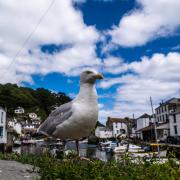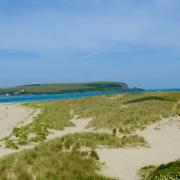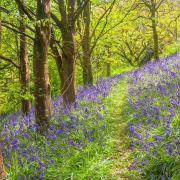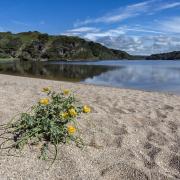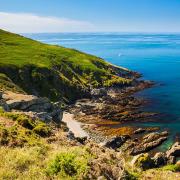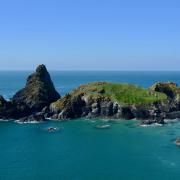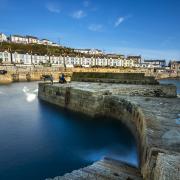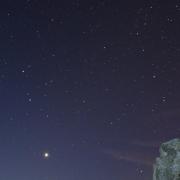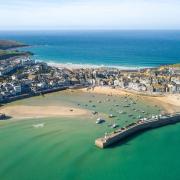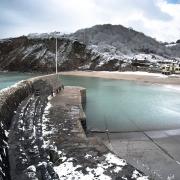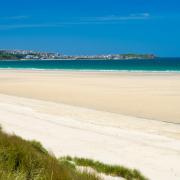Award-winning photographer David Chapman goes in search of the Rame Peninsula

This small AONB takes in Rame Head, Penlee Point, Kingsand and Cawsand, Mount Edgcumbe Country Park and the southern edge of Millbrook Lake.
Last year in Cornwall Life I recounted the details of a week-long trip I took to Rame Head in July two years ago. I spent a week at Penmillard Farm, a small Caravan and Motorhome Club site, exploring the area on foot, bike, bus and ferry.
One of the things I like about a holiday in Cornwall is being able to park the van and rely only on foot and public transport to get around. The Rame Head AONB, being quite small, is an ideal one for this type of trip. On Rame Head I explored Kingsand and Cawsand; wandered the extensive Country Park at Mount Edgcumbe, complete with house and formal gardens; walked the coast path and spent some quality time at a Cornwall Wildlife Trust nature reserve at Penlee Battery. Beyond the boundary of the AONB, but still within easy reach, I visited Antony House and the Woodland Garden and took the ferry to Plymouth so I could get a view of Cornwall from the other side of the Tamar!
In fact it was the chance to go to Penlee Battery (Cornwall Wildlife Trust Reserve) which influenced my decision to visit Rame Head in July. I had heard it is a great place to see marbled white butterflies and I wanted to go and take some photos of them. While I was there I also found plenty of other butterflies including gatekeeper, comma, common blue, small tortoiseshell, and moths such as the six-spot burnet, silver-Y and cream spotted tiger. So I am going to break with tradition in this article by featuring some tips on photographing butterflies rather than views.

When I talk about photographing scenes I often stress the importance of using foreground to complete the image. Well with close-up photography the opposite is true. It’s all about background. This isn’t as peculiar as it might sound at first. Think about it. When you take a photograph of a landscape you probably have a distant focal point in mind and there is a lot of ground between you and the focal point, which gives you the opportunity to use foreground to complete the picture. When you are photographing something close up, like a butterfly, you usually want as little as possible between you and the subject but you will inevitably have ‘clutter’ in the background. Your job as a photographer is to make this ‘clutter’ as attractive as possible or send it out of focus to make it less distracting.
Photographing butterflies and other flying-things is made difficult by the fact that they don’t sit still. If you see a butterfly alighting on a flower you will have a limited time to get into position to get a photo before it flies off. In that time you have to be careful not to disturb the vegetation on which the butterfly is resting and not to cast your own shadow on it. You also have to try to get square-on to the back of the butterfly and wait for it to open its wings fully if you are to get it all sharp. Not a big ask!
One thing that is clear from this is the need for the photographer to know their camera inside and out. The last thing you want to be doing when you eventually get into a suitable position is to be messing around changing your camera’s settings. Speed is of the essence, it might be worth practicing on some flowers first, they don’t move around quite as much.
If you are dedicated enough there are ways of improving your chances. Some butterflies are obvious enough or numerous enough to be able to find at roost. At Penlee Battery I visited in the evening and watched where the marbled white butterflies settled down to sleep. They seemed to like to do this in loose clusters of like-minded individuals, often at the top of tall grasses. If there was still enough light when they did this I could take photos when they settled down, if not I remembered where they were and came back again first thing the following morning.

In the morning butterflies are quite slow to get up. Even with the early morning sun on their backs they take a while to start flying, particularly if it was a cold night. It helps if the morning is calm, because tall grasses do blow around a lot but all being well, and with the help of a tripod it is possible to spend a bit more time thinking about composition and angle of light when the butterflies are calm.
I found myself using two types of lenses. A macro lens for the traditional close-up photos and a telephoto lens when I wanted to shoot backlit or if I really wanted to pick out a small area of background. Backlighting can work well on golden grasses, shining through the grass seed heads and rim-lighting the butterfly but this strategy is best when the sun is low in the sky, otherwise the sun is just too bright.
It isn’t easy being up before a butterfly on a fine summer’s day but to see these wonderfully intricate and beautiful creatures in the early morning sun is a treat and with some great photos in the bag there is the rest of the day to enjoy a lovely walk through The Rame AONB, perfect!
THE WILDLIFE

Apart from Penlee Battery for flowers and insects try: Millbrook Lake for bird watching with a variety of waders and wildfowl, particularly good on a rising tide; Mount Edgcumbe has plenty of cultivated flowers which can attract butterflies such as the silver-washed fritillary; Rame Head can be good for spotting kestrel, peregrine, raven and occasional rare birds in spring and autumn; fallow deer can be found throughout the AONB but the deer park at Mount Edgcumbe is particularly good (though the deer are not captive any more).
THE TECHNICAL
In the middle of the day I take close up photos without a tripod. The light is bright enough to shoot hand-held so long as your camera can achieve a shutter speed of about 1/250th second or faster. But for shooting early or late in the day when the sun is lower I will always use a tripod.
One of the best investments for anyone interested in close up photography of flowers and insects is a tripod which will get down to ground level. As well as having three legs most tripods have a central column. To get down to ground level the legs must open out flat and the central column must push up and over into a horizontal position.

Compact and bridge cameras are very good for photographing close-up subjects, often focussing very close but they do sometimes struggle to find the subject to focus on! If this happens to you try focussing on something close by then half press the shutter button to lock the focus, then recompose the image with the subject back in frame and move yourself slightly back or forth until the subject is sharp. Then fully depress the shutter button to take the photo. This might sound tricky but is easy enough with practice.
If you use a DSLR or mirrorless camera you will need to buy a macro lens for close-up photography. I use a 100mm macro lens.
THE PRACTICALITIES

Car parking is available at Mount Edgcumbe Country Park, Rame Head, Cawsand and Penlee Battery. It is possible to travel from Plymouth by foot ferry to Cremyll (all year) or Cawsand (summer) and there is a bus service which travels along the peninsula. Cafes and facilities are available at Mount Edgcumbe and Cawsand. I like to park at Rame Head and walk the coast path to Mount Edgcumbe for lunch, this covers the entire length of the AONB in one day, but there is much more to see than just the coast path. u
David Chapman has published a number of books featuring his wildlife and landscape photography. This article first appeared in Cornwall Life - see our latest subscription offers here












